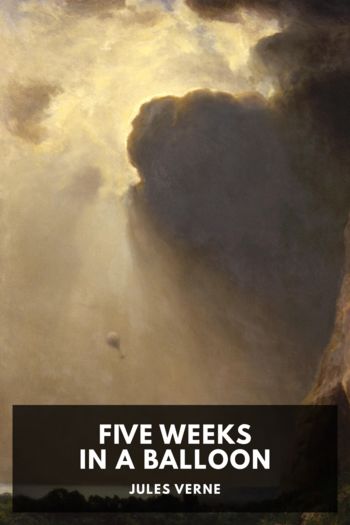From the Earth to the Moon Jules Verne (speed reading book .TXT) 📖

- Author: Jules Verne
Book online «From the Earth to the Moon Jules Verne (speed reading book .TXT) 📖». Author Jules Verne
“Regarding question No. 6, ‘What place will the moon occupy In the heavens at the moment of the projectile’s departure?’
“At the moment when the projectile is hurled into space, the moon, which travels forward 13° 0′ 5″ each day, will be four times as distant from her zenith point—i.e., by 52° 2′ 0″, a space which corresponds to the distance she will travel during the transit of the projectile. But as the deviation which the rotatory movement of the earth will impart to the shock must also be taken into account, and as the projectile cannot reach the moon until after a deviation equal to sixteen radii of the earth, which, calculated upon the moon’s orbit, is equal to about 11°, it is necessary to add these 11° to those caused by the already-mentioned delay of the moon, or, in round numbers, 64°. Thus, at the moment of firing, the visual radius applied to the moon will describe with the vertical line of the place an angle of 64°.
“Such are the answers to the questions proposed to the Observatory of Cambridge by the members of the Gun Club.
“To sum up—
“The cannon must be placed in a country situated between 0° and 28° of north or south latitude.
“It must be aimed at the zenith of the place.
“The projectile must have an initial speed of 12,000 yards a second.
“It must be hurled on December 1st of next year, at 10hrs, 46mins, 40secs.
“It will meet the moon four days after its departure on December 4th, at midnight precisely, at the moment she arrives at her zenith.
“The members of the Gun Club ought, therefore, at once to commence the labour necessitated by such an enterprise, and be ready to put them into execution at the moment fixed upon, for they will not find the moon in the same conditions of perigee and zenith till eighteen years and eleven days later.
“The staff of the Observatory of Cambridge puts itself entirely at their disposition for questions of theoretic astronomy, and begs to join its congratulations to those of the whole of America.
“On behalf of the staff,
“J. M. Belfast, Director of the Observatory of Cambridge.”
The Romance of the MoonA spectator endowed with infinite power of sight, and placed at the unknown centre round which gravitates the universe, would have seen myriads of atoms filling all space during the chaotic epoch of creation. But by degrees, as centuries went on, a change took place; a law of gravitation manifested itself which the wandering atoms obeyed; these atoms, combined chemically according to their affinities, formed themselves into molecules, and made those nebulous masses with which the depths of the heavens are strewed.
These masses were immediately animated by a movement of rotation round their central point. This centre, made of vague molecules, began to turn on itself whilst progressively condensing; then, following the immutable laws of mechanics, in proportion as its volume became diminished by condensation its movement of rotation was accelerated, and these two effects persisting, there resulted a principal planet, the centre of the nebulous mass.
By watching attentively the spectator would then have seen other molecules in the mass behave like the central planet, and condense in the same manner by a movement of progressively-accelerated rotation, and gravitate round it under the form of innumerable stars. The nebulae, of which astronomers count nearly 5,000 at present, were formed.
Amongst these 5,000 nebulae there is one that men have called the Milky Way, and which contains eighteen millions of stars, each of which has become the centre of a solar world.
If the spectator had then specially examined amongst these eighteen millions of stars one of the most modest and least brilliant, a star of the fourth order, the one that proudly named itself the sun, all the phenomena to which the formation of the universe is due would have successively taken place under his eyes.
In fact, he would have perceived this sun still in its gaseous state, and composed of mobile molecules; he would have perceived it turning on its own axis to finish its work of concentration. This movement, faithful to the laws of mechanics, would have been accelerated by the diminution of volume, and a time would have come when the centrifugal force would have overpowered the centripetal, which causes the molecules all to tend towards the centre.
Then another phenomenon would have passed before the eyes of the spectator, and the molecules situated in the plane of the equator would have formed several concentric rings like that of Saturn round the sun. In their turn these rings of cosmic matter, seized with a movement of rotation round the central mass, would have been broken up into secondary nebulae—that is to say, into planets.
If the spectator had then concentrated all his attention on these planets he would have seen them behave exactly like the sun and give birth to one or more cosmic rings, origin of those secondary bodies which we call satellites.
Thus in going up from the atom to the molecule, from the molecule to the nebulae, and from the nebulae to the principal star, from the principal star to the sun, from the sun to the planet, and from the planet to the satellite, we have the whole series of transformations undergone by the celestial powers from the first days of the universe.
The sun seems lost amidst the immensities of the stellar universe, and yet it is related, by actual theories of science, to the nebula of the Milky Way. Centre of





Comments (0)